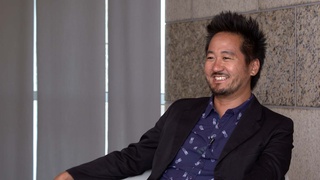Interviews
Perceptions of uniqueness
One interesting story about the Hapa Project is that I would get people from very homogenous areas. I had a woman write me from Oklahoma who wrote me and said “You must fly out to Oklahoma to photograph me for this because you’ll never believe it, I’m black and Korean!” I didn’t know what to say, that her world was that small, that to her that she was the only one in the world. In some sense that’s great, but I had to write to her, I said “I would love to photograph you, but I can’t fly out there, and I’ve photographed probably fifty people that are black Korean. Just so you know there’s other people out there.” I wanted it to be a kind of positive thing, that she’d know, but I think she kind of felt like she wasn’t “the one” anymore, she wasn’t Keanu Reeves in The Matrix, and she never wrote me back again.
Date: May 3, 2006
Location: California, US
Interviewer: Jim Bower
Contributed by: Watase Media Arts Center, Japanese American National Museum.
Explore More Videos

Pop and Balls
(1938-2020) Japanese American attorney and civil rights activist

Re-examining Identity
(1941-2018) Japanese Canadian photojournalist and activist

Fitting in to both sides of her family
Jewish Japanese American journalist


Culture is an important part of one's identity
Jewish Japanese American journalist



Conflicted about immigrating to America (Japanese)
(b. 1925) War bride

Defining "Nikkei"
(1941-2018) Japanese Canadian photojournalist and activist

Unique Identity from Having Multiple Backgrounds
(b. 1938) Philipines-born hikiagesha who later migrated to the United States.

Growing up Japanese in Hawaii
(b. 1952) Former banking executive, born in Hawaii



Parents identification as Peruvian Okinawan
Okinawan American whose parents are from Peru.

Okinawan cultural appreciation
Okinawan American whose parents are from Peru.
